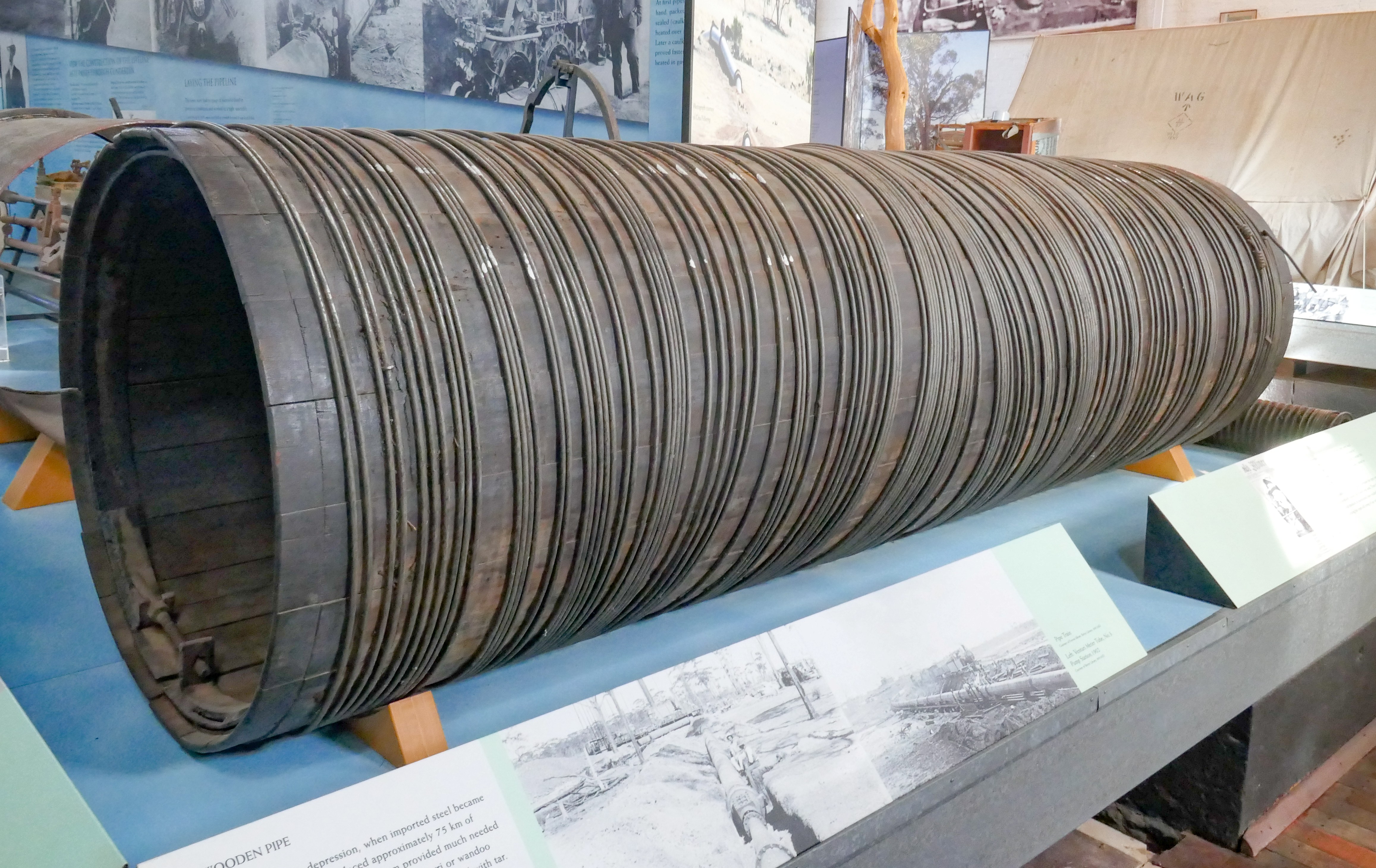Wooden pipes to the rescue
By Judy Evans
@JudyEv (366290)
Rockingham, Australia
August 25, 2025 8:21pm CST
I’ve written before about the Goldfields pipeline in Western Australia. When gold was discovered at Kalgoorlie, 600 kms (372 miles) inland from Perth, there
was a desperate need to provide water to the area. Trying to source water occupied more or the prospectors' time and effort than digging for gold.
The pipeline was commissioned in 1896 and completed in 1903. In the beginning, corrosion of the buried steel pipes was a problem and some of the lengths of steel pipe were replaced with wooden ones.
They were first made of Oregon timber but later karri was used. The lengths or staves were treated with sodium fluoride and kiln dried. They were then bound with galvanised wire before being covered in tar and bitumen, and dipped in whitewash. They were then closed at each end and filled with water. This caused the staves to swell sealing the pipe.
The photo shows one of the wooden lengths of pipe.
17 people like this
13 responses
@YuleimaVzla (1857)
• Maracaibo, Venezuela
26 Aug
How interesting here in Venezuela we still use steel pipes and although it is a fairly strong material, leaks still occur, but most companies do not take them into Seriously, the care and environmental impact, because they do oil companies invest little in preventive care of their pipelines?
3 people like this
@JudyEv (366290)
• Rockingham, Australia
27 Aug
@YuleimaVzla Some stains are impossible to remove.
1 person likes this
@YuleimaVzla (1857)
• Maracaibo, Venezuela
26 Aug
@JudyEv You and I are not even petroleum engineers hahaha and we are investigating what the pipes are made of, the truth is that here they are made of steel and I have always seen that there are many leaks, there are roads with Oil spills and the truth is it's unpleasant because it passes through residential areas. Once I lost a pair of pants because they got stained passing through there.
1 person likes this

@BloggerDi (3121)
• United States
26 Aug
Hi Judy. Wow, that's so interesting! I'd never heard of water pipes made of wood. I wonder how long they lasted?
3 people like this
@ptrikha_2 (48786)
• India
26 Aug
I have heard of such a use of Wood for the first time.
This seems like a very unique way as mostly steel pipes are used for such activities!
1 person likes this
@ptrikha_2 (48786)
• India
27 Aug
@JudyEv
Even now it is so.
Some Firms pay good attention to the quality of the material.
Others do not.
So at times, things deteriorate very fast!
1 person likes this
@ptrikha_2 (48786)
• India
30 Aug
@JudyEv
And others get caught up sooner or later.
I am not sure if you remember a big US consulting firm of 1990s and may be early 2000s- Anderson Consulting.
It was very popular. It was a big name.
Yet one of its top bosses was convicted big time and I do not think the firm exists any longer.
1 person likes this

@allknowing (153986)
• India
26 Aug
Wood, pipes and water - this does not look like a possible combination but it has been made possible How pipes can be made using wood has gone over my head
I can only think of scooping out huge tree trunks
1 person likes this

@allknowing (153986)
• India
26 Aug
@JudyEv They will have to do so much of joining both breadthwise and lengthwise
1 person likes this
@JudyEv (366290)
• Rockingham, Australia
26 Aug
@allknowing True. I'm sure it was quite a slow process.
1 person likes this
@Deepizzaguy (116452)
• Lake Charles, Louisiana
27 Aug
Good liking water pipe that have shared on this post.
1 person likes this
@rsa101 (40491)
• Philippines
26 Aug
That’s really fascinating! I’m in awe that wooden pipes could actually serve such an important role in transporting water over such distances. It’s amazing how resourceful people were back then, making use of what they had and making it work. Maybe it lasted so well because of the very dry conditions in that part of Australia. If it were here in our very humid climate, I doubt the wood would have survived that long—it would probably rot or weaken much faster. Still, it’s a brilliant piece of history and engineering.
1 person likes this
@JudyEv (366290)
• Rockingham, Australia
27 Aug
There were a lot of leaks and 'blow-outs' over the years.
@JudyEv (366290)
• Rockingham, Australia
26 Aug
The women of the day campaigned for the use of wooden pipes so their menfolk would have employment during the Depression.
@sallypup (66919)
• Centralia, Washington
26 Aug
I've heard of a museum dedicated to the history of pipes. We had quite a time at my house. I asked a worker to fix a leaky outside faucet. He thought it would be simple. Then he discovered an 8 foot long pipe under the house and that pipe, being over 100 years old, thicker than modern. He had to go find a hand tool to help him retrofit the pipe so that he could put fittings on it. He also charged us a little more money for the effort.
1 person likes this
@JESSY3236 (21277)
• United States
26 Aug
That's so cool. Never heard of wooden pipes before.
1 person likes this
@LindaOHio (207160)
• United States
26 Aug
I've never heard of wooden pipes. Very interesting.
1 person likes this



















